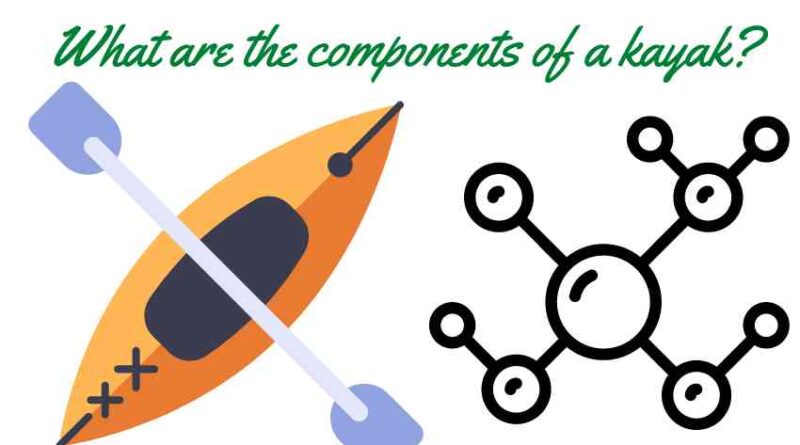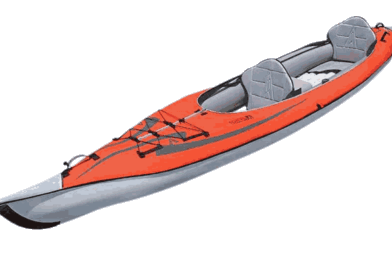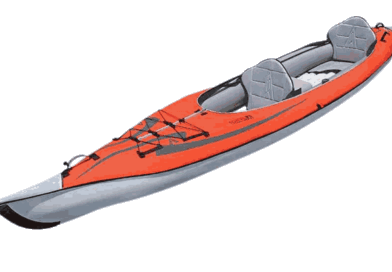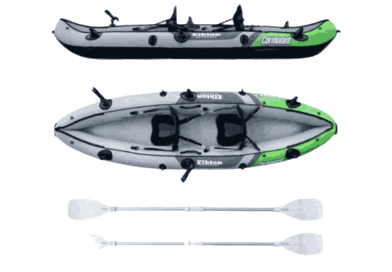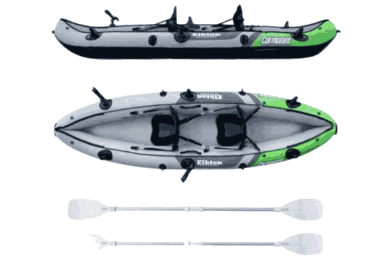What are the components of a kayak? – Answering FAQs
Kayak Components Unveiled: Everything You Need to Know
Are you ready to hit the water and navigate through the waves with ease?
Before you do, it’s important to understand the key components that make up a kayak.
From the sides to the bottom and every feature in between, knowing the ins and outs of your kayak will make all the difference in your paddling experience.
In this article, we’ll cover the major parts, terminology, and features of a kayak, including what makes it stable, the purpose of a chine, and even what to call a two-man kayak.
So, whether you’re a seasoned pro or just getting started, join us as we dive into the world of kayaking and discover the essential components that make up this exciting water sport.
Table of Contents
What are the components of a kayak?
A kayak is made up of 7 important parts: the front (bow) and back (stern), the deck and hull (the top and bottom of the kayak), the cockpit (where you sit), foot rests (to keep you steady), and the seat (where you sit comfortably). These parts work together to help you paddle and steer your kayak through the water.
Now that we know the components of a kayak, let’s discuss the best transport options for this watercraft.
What are the major parts of a kayak?
A kayak has many parts that help it move through the water.
The main body is called the hull, and the top part is the deck. The cockpit is where you sit, and there’s a seat and footrests to help you stay comfortable.
You use a paddle to move, and a rudder or skeg to steer. The front is the bow, and the back is the stern. There are also grab handles and bungee cords to help carry and store things.
| Part | Description |
|---|---|
| Hull | Body of kayak |
| Deck | Top part of kayak |
| Cockpit | Where paddler sits |
| Seat | For sitting in cockpit |
| Footrests | Support for feet |
| Paddle | For moving kayak |
| Rudder/Skeg | For steering kayak |
| Bow | Front of kayak |
| Stern | Back of kayak |
| Grab handles | For carrying kayak |
| Bungee cords | For storing gear |
Now let’s take a closer look at the major points of a kayak.
What are the major points of a kayak?
| Part | Description |
|---|---|
| Hull | Body of kayak, determines stability and speed |
| Cockpit | Where paddler sits |
| Deck | Top part of kayak, provides storage space |
| Seat | For sitting, made of cushioning materials |
| Foot braces | Adjustable pedals for balance and control |
| Paddle | For moving kayak |
| Rudder | Movable blade for steering |
| Skeg | Fixed blade for tracking straight |
| Spray skirt | Waterproof cover to keep water out |
| Handles | For carrying and maneuvering kayak |
What are the sides of a kayak called?
When you’re paddling your kayak, it’s helpful to know the special names of the different parts!
The front of the kayak is called the bow, and the back is called the stern. The left side is called port, and the right side is called starboard. Remembering these terms will help you communicate with other kayakers and navigate the water like a pro!
Speaking of kayak parts, you might be wondering about the bottom of the kayak.
What is the bottom of a kayak called?
The bottom of a kayak is called the hull. It’s like the foundation of a house, keeping the kayak afloat. You’ll also notice a ridge on the back called the keel.
And when someone says “port,” they mean the left side of the boat. Now you know the lingo for your next kayaking adventure!
Now that we know what the bottom of a kayak is called, let’s explore what factors contribute to its stability.
What makes a kayak stable?
A kayak that is wider is usually more stable than a narrow one. This is because the wider surface area helps to prevent the kayak from tipping over to the side. So, if you want to feel more secure while kayaking, choose a wider kayak!
Speaking of the design of a kayak, have you heard of the term “chine”?
What is a chine on a kayak?
Have you ever wondered what the chine on a kayak is? Well, it’s actually the spot where the bottom and sides of the boat come together.
It’s an important part of the kayak because it helps with stability and steering. Think of it like a secret weapon that helps you glide effortlessly across the waves!
Speaking of kayak parts, another important feature is…
What is the opening in a kayak's deck called?
The opening in a kayak’s deck where the paddler sits is called the cockpit. It’s like the driver’s seat in a car, but for kayaking!
Cockpits are only found in sit-inside kayaks and come in different sizes depending on the type of kayak.
Now that we know what the cockpit is, let’s explore the features of a recreational kayak.
What are the features of a recreational kayak?
A recreational kayak is different from other big kayaks. It has a large, easy-to-open cockpit so you can get in and out easily. It’s also wider, about 27-30 inches, for more stability in the water. And it’s usually shorter than 12 feet. These features make it a great choice for having fun on the water!
Now, moving on to another aspect of kayaking, let’s discuss the function of a skeg on a kayak.
What is a skeg on a kayak?
A skeg is like a secret weapon for your kayak! It’s a special blade that can be lowered down from a slot near the back of the kayak to help keep you going straight when the wind or waves try to push you off course. You can control it with a slider near your seat. It’s like having a superhero power for your boat!
Moving on to another type of kayak, do you know what a two-man kayak is called?
What is a two-man kayak called?
A two-man kayak, also known as a tandem kayak, is a type of boat that can fit two people. It’s perfect for when you want to paddle with a friend or family member. Our Perception Cove 14.5 kayaks are great for when you want to bring a small child along or if one person wants to take it easy.
It’s a fun way to explore the water together.
Speaking of kayaking, have you ever wondered what it’s called when you flip over in a kayak?
What is it called when you flip over in a kayak?
Don’t worry if your kayak flips over, it’s called a capsize. It’s actually pretty rare for someone to stay inside the kayak when it flips over.
Even though the cockpit may look like it’s enclosing you, there’s actually lots of space around your body. So if you do capsize, you’ll be able to get out of the kayak easily.
Frequently Asked Questions
What are the different types of kayaks and how do they differ in their components and major parts?
The different types of kayaks include recreational, touring, whitewater, inflatable, and fishing. They differ in their size, shape, and materials used for construction.
How do the sides and bottom of a kayak affect its stability and maneuverability?
The shape and design of the sides and bottom of a kayak can affect its stability and maneuverability. Wider, flatter bottoms provide more stability, while narrower, more rounded bottoms allow for greater maneuverability.
Similarly, flared sides increase stability, while straighter sides allow for better maneuverability.
What are the key features to look for in a recreational kayak, and how do they differ from other types of kayaks?
Key features to look for in a recreational kayak include stability, comfort, and ease of use. They differ from other types of kayaks in their focus on leisurely paddling rather than performance.
How does a skeg on a kayak help with navigation and control in different water conditions?
A skeg on a kayak helps with navigation and control in different water conditions by providing stability in windy or choppy conditions. It can be adjusted to help the kayak track straight in a crosswind or current.
What are some safety tips for avoiding capsizing or flipping over in a kayak, and what should you do if it happens?
Safety tips for avoiding capsizing or flipping over in a kayak include wearing a life jacket, paddling in calm waters, staying aware of weather conditions, and avoiding sudden movements.
If capsizing does occur, stay with the kayak, hold onto the paddle, and try to climb back in if possible.
What Can you do now?
Now that you know all about the components of a kayak, it’s time to hit the water and put your knowledge to the test! If you’re in the market for a new kayak, why not check out our review of the 12 best kayaks on the market? With our expert recommendations, we hope you’ll find the perfect kayak for your next adventure.
If you’re curious about the benefits of kayaking, why not check out our next article? Discover how this popular water sport can help strengthen your body, tone your arms and legs, and even reduce stress and anxiety. Click on the link to learn more about the physical and mental advantages of kayaking. Happy Paddling.
